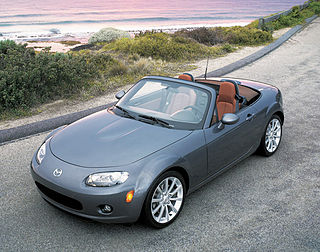
A convertible or cabriolet is a passenger car that can be driven with or without a roof in place. The methods of retracting and storing the roof vary among eras and manufacturers.

Personal luxury car is a North American car classification describing somewhat sporty, sophisticated mass-market coupés that emphasized comfort over performance. The North American manufacturers most often combined engineering, design, and marketing to develop upscale, distinctive "platform sharing" models that became highly profitable.

The term 1932 Ford may refer to three models of automobile produced by Ford Motors between 1932 and 1934: the Model B, the Model 18, and the Model 40. These succeeded the Model A. The Model B had an updated four-cylinder engine and was available from 1932 to 1934. The V8 was available in the Model 18 in 1932, and in the Model 40 in 1933 & 1934. The 18 was the first Ford fitted with the flathead V-8. The company also replaced the Model AA truck with the Model BB, available with either the four- or eight-cylinder engine.

The North American International Auto Show (NAIAS), also known as the Detroit Auto Show as of 2022 and prior to NAIAS, is an annual auto show held in Detroit, Michigan, U.S., at Huntington Place. The show was held in January from 1989 to 2019. It was intended to move to the summer in 2020, but was canceled due to the COVID-19 pandemic that year and 2021, before returning in September 2022. It is among the largest auto shows in North America. UPI says the show is "regarded as the foremost venue for [car] manufacturers to unveil new products".
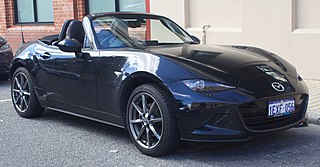
A roadster is an open two-seat car with emphasis on sporting appearance or character. Initially an American term for a two-seat car with no weather protection, usage has spread internationally and has evolved to include two-seat convertibles.

The Chrysler Royal was a full-size car produced by the Chrysler Corporation in the United States. It was firstly released in 1933 and continued being built until 1934. Then, the model ended production and did not return until 1937 - continuing until 1950.

The Ace was an American-assembled car made in Ypsilanti, Michigan by the Apex Motor Car Company, which was reorganized as the Apex Motor Corporation in 1921. The initial batch of cars assembled were sent to Seattle, Washington dealer F. E. Earnest, who had the idea for the Ace after he was unable to secure a steady supply of new cars for his dealership.
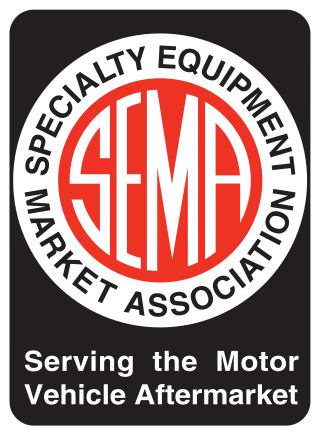
Specialty Equipment Market Association (SEMA) of the automobile aftermarket was formed in 1963 by Roy Richter, Ed Iskenderian, Els Lohn, Willie Garner, Bob Hedman, Robert E. Wyman, John Bartlett, Phil Weiand Jr, Al Segal, Dean Moon, and Vic Edelbrock Jr. and now consists of 6,383 companies worldwide, bringing together aftermarket manufacturers, original equipment manufacturers (OEM), media, car dealers, specialty equipment distributors, installers, retailers, and restoration specialists.

The Los Angeles Auto Show, also known as the LA Auto Show, is an auto show held annually at the Los Angeles Convention Center in Los Angeles, California, United States. It is open to the public for ten days, filling 760,000 square feet (71,000 m2) of exhibit space. Since 2006 the event is held in November or December.
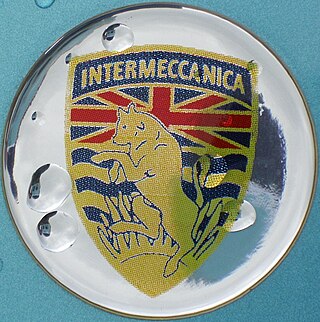
Intermeccanica is an automobile manufacturer, founded in Torino, Italy, in 1959 by Frank Reisner. It subsequently moved first to the United States, then to Canada, and is currently headed by Frank's son, Henry Reisner.

In the late 1920s, American automotive company General Motors (GM) launched four companion makes to supplement its existing lineup of five-passenger car brands, or makes. The companion makes were LaSalle, introduced for the 1927 model year to supplement Cadillac; Marquette, introduced in 1929 for 1930 to supplement Buick; Pontiac, introduced for 1926 to supplement Oakland; and Viking, introduced for 1929 to supplement Oldsmobile. GM's fifth existing brand, Chevrolet, did not receive a companion make. With the exception of Viking, each of the companion makes were slotted below their "parent make" in GM's pricing hierarchy.
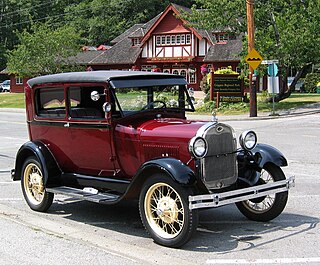
The Ford Model A was the Ford Motor Company's second market success, replacing the venerable Model T which had been produced for 18 years. It was first produced on October 20, 1927, but not introduced until December 2. This new Model A was designated a 1928 model and was available in four standard colors.

The 1949 Ford is a line of cars produced by Ford from the 1949 to 1951 model years. The successor to the prewar 1941 Ford, the model line was the first full-size Ford designed after World War II, becoming the first Ford car line released after the deaths of Edsel Ford and Henry Ford. From 1946 to 1948, each of the American Big Three concentrated on the restoration of car production, offering updated versions of their 1941-1942 model lines. Released in June 1948, the 1949 Ford was the first major "postwar" American car line, beating Chevrolet to market by six months and Plymouth by nine.

A ute, originally an abbreviation for "utility" or "coupé utility", is a term used in Australia and New Zealand to describe vehicles with a tonneau behind the passenger compartment, that can be driven with a regular driver's license.

The Western Antique Aeroplane and Automobile Museum (WAAAM) is located in Hood River, Oregon, United States, adjacent to the Ken Jernstedt Memorial Airport. WAAAM is a nonprofit 501(c)(3) organization committed to the preservation of, and education about aviation, automobile, and other historic transportation-related relics.
This is a list of automobiles produced for the general public in the North American market. They are listed in chronological order from when each model began its model year. If a model did not have continuous production, it is listed again on the model year production resumed. Concept cars and submodels are not listed unless they are themselves notable.

A coupé utility is a vehicle with a passenger compartment at the front and an integrated cargo tray at the rear, with the front of the cargo bed doubling as the rear of the passenger compartment.

The Martin Auto Museum is a privately owned non-profit automobile museum located in Glendale, Arizona. The museum is dedicated to the preservation of collectible automobiles for educational purposes. Admission is a $10 donation per person over the age of 12. Some of the services provided by the museum include guided tours for such groups as local schoolchildren, veteran organizations and car clubs.

The Oldsmobile Light Eight was an automobile produced by the Oldsmobile Division of General Motors in roadster, two-door coupe, four-door sedan from between 1916 and 1923. It was powered by a sidevalve V8 engine, the maker's first, and shared with the 1916 Oakland Model 50.

The Oakland Model A was the first four-cylinder engine offered by the Oakland Motor Company in 1907 which became a division of General Motors in 1909. The Model A was developed and manufactured from former Oakland Motor Company sources while the engine was provided by Northway Motor and Manufacturing Division of GM of Detroit. The Model A was available in several body styles and prices ranged from US$1,300 to US$2,150. Once Oakland became a division of GM, Oldsmobile and Buick shared bodywork and chassis of their four-cylinder models with Oakland. Manufacture of the Oakland was completed in Pontiac, Michigan. Oakland (Pontiac) wouldn't use another 4-cylinder engine until 1961 with the Pontiac Trophy 4 engine.



















